Business Communications: Social Media in the Workplace Report Analysis
VerifiedAdded on 2022/09/11
|9
|2085
|11
Report
AI Summary
This report outline and resource analysis examines how Royal Prince Alfred Hospital (RPAH) can utilize social media to improve workplace communication. The report's introduction highlights the importance of social media for efficient information flow and stakeholder engagement. It provides an overview of RPAH, a renowned teaching hospital, and its potential to enhance operations through social media. The report will address communication issues, and explore solutions using platforms like Facebook, YouTube, Twitter, Instagram, and LinkedIn. The report analyzes four resources: two journal articles exploring social media's impact on employee engagement and productivity, and two website/blog articles discussing social media in the workplace. Each resource is evaluated based on authority, audience, transparency, objectivity, and currency. The conclusion will address how RPAH can benefit from social media, its impact on productivity, and its long-term implications. Recommendations will be provided to improve communication strategies using social media platforms.
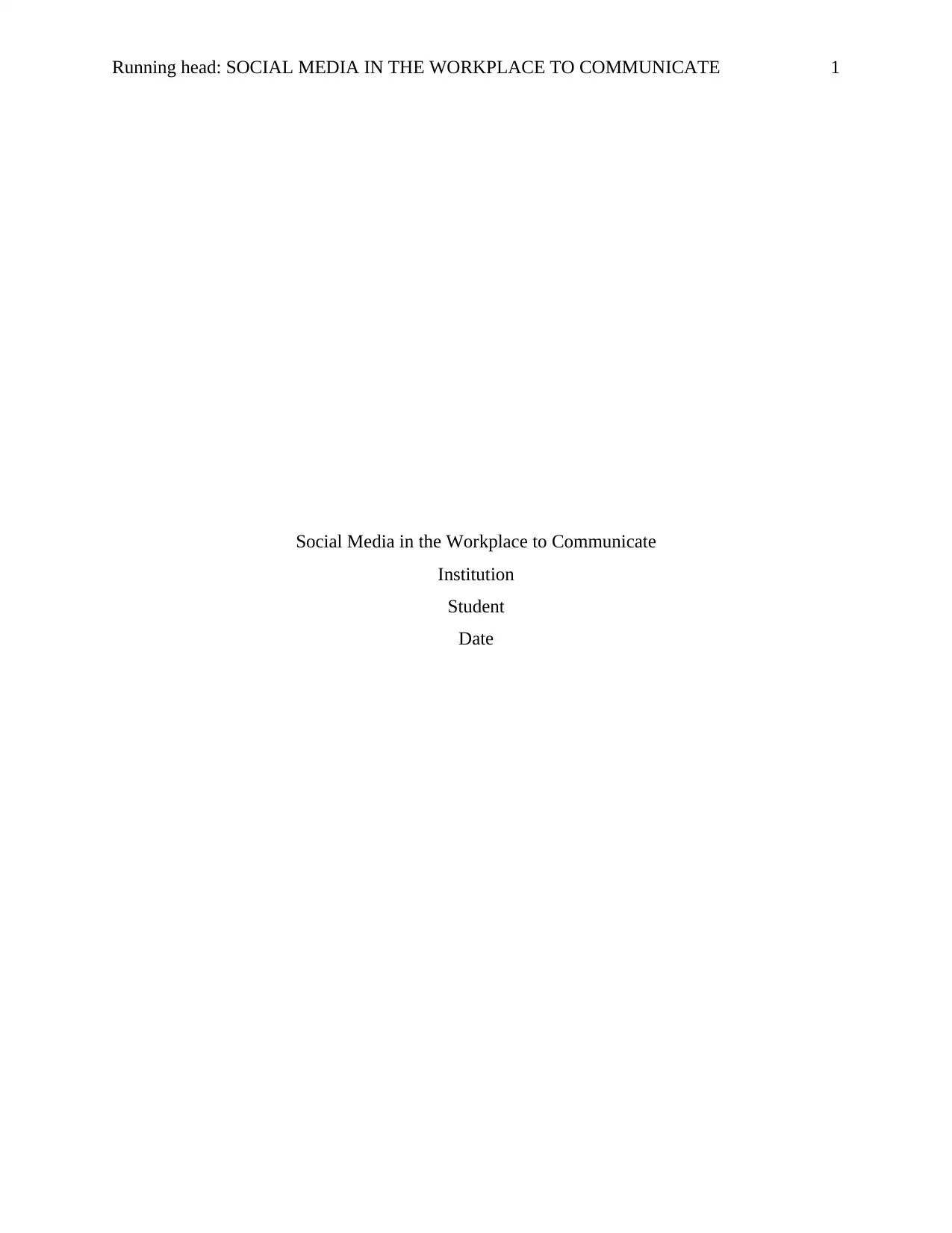
Running head: SOCIAL MEDIA IN THE WORKPLACE TO COMMUNICATE 1
Social Media in the Workplace to Communicate
Institution
Student
Date
Social Media in the Workplace to Communicate
Institution
Student
Date
Paraphrase This Document
Need a fresh take? Get an instant paraphrase of this document with our AI Paraphraser
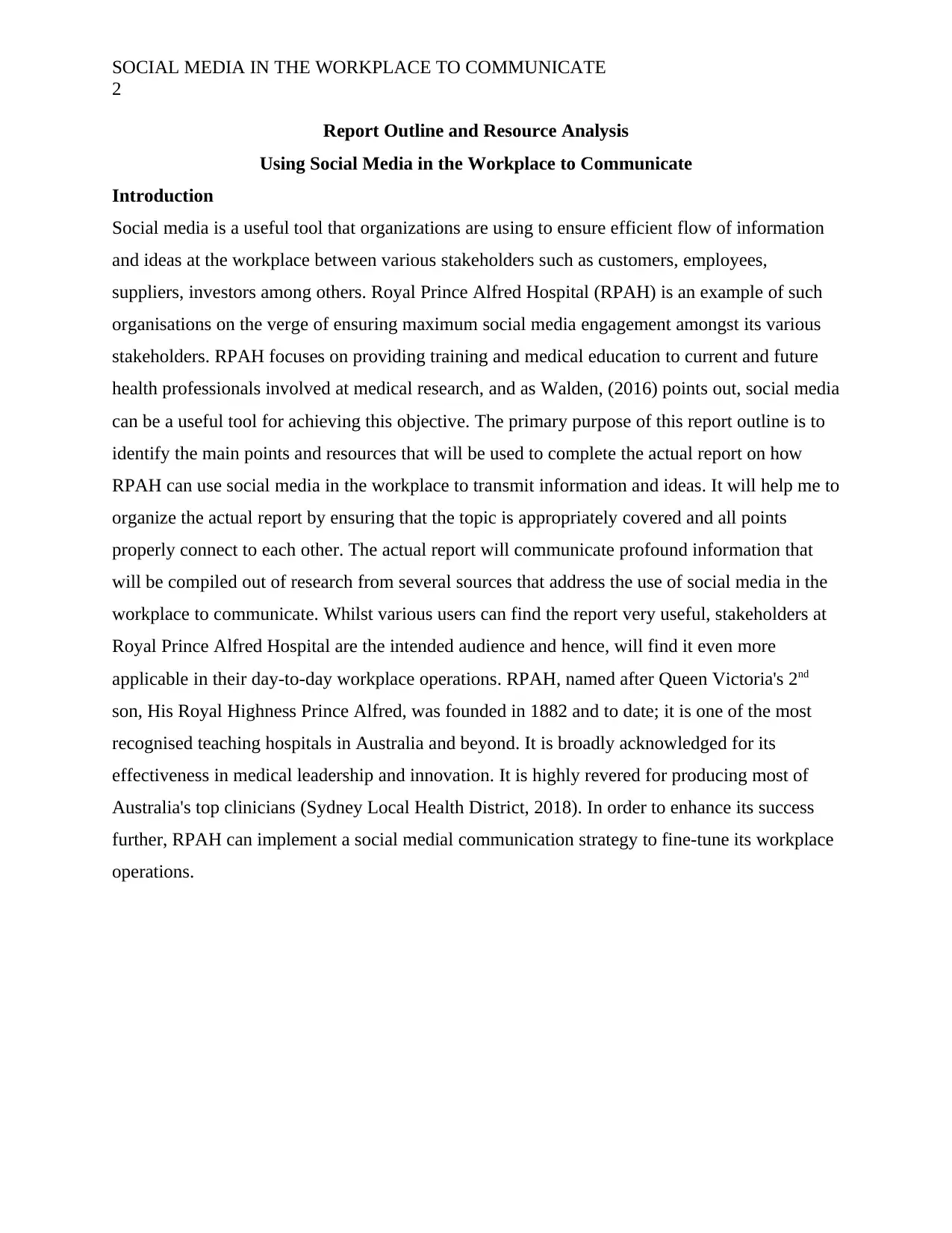
SOCIAL MEDIA IN THE WORKPLACE TO COMMUNICATE
2
Report Outline and Resource Analysis
Using Social Media in the Workplace to Communicate
Introduction
Social media is a useful tool that organizations are using to ensure efficient flow of information
and ideas at the workplace between various stakeholders such as customers, employees,
suppliers, investors among others. Royal Prince Alfred Hospital (RPAH) is an example of such
organisations on the verge of ensuring maximum social media engagement amongst its various
stakeholders. RPAH focuses on providing training and medical education to current and future
health professionals involved at medical research, and as Walden, (2016) points out, social media
can be a useful tool for achieving this objective. The primary purpose of this report outline is to
identify the main points and resources that will be used to complete the actual report on how
RPAH can use social media in the workplace to transmit information and ideas. It will help me to
organize the actual report by ensuring that the topic is appropriately covered and all points
properly connect to each other. The actual report will communicate profound information that
will be compiled out of research from several sources that address the use of social media in the
workplace to communicate. Whilst various users can find the report very useful, stakeholders at
Royal Prince Alfred Hospital are the intended audience and hence, will find it even more
applicable in their day-to-day workplace operations. RPAH, named after Queen Victoria's 2nd
son, His Royal Highness Prince Alfred, was founded in 1882 and to date; it is one of the most
recognised teaching hospitals in Australia and beyond. It is broadly acknowledged for its
effectiveness in medical leadership and innovation. It is highly revered for producing most of
Australia's top clinicians (Sydney Local Health District, 2018). In order to enhance its success
further, RPAH can implement a social medial communication strategy to fine-tune its workplace
operations.
2
Report Outline and Resource Analysis
Using Social Media in the Workplace to Communicate
Introduction
Social media is a useful tool that organizations are using to ensure efficient flow of information
and ideas at the workplace between various stakeholders such as customers, employees,
suppliers, investors among others. Royal Prince Alfred Hospital (RPAH) is an example of such
organisations on the verge of ensuring maximum social media engagement amongst its various
stakeholders. RPAH focuses on providing training and medical education to current and future
health professionals involved at medical research, and as Walden, (2016) points out, social media
can be a useful tool for achieving this objective. The primary purpose of this report outline is to
identify the main points and resources that will be used to complete the actual report on how
RPAH can use social media in the workplace to transmit information and ideas. It will help me to
organize the actual report by ensuring that the topic is appropriately covered and all points
properly connect to each other. The actual report will communicate profound information that
will be compiled out of research from several sources that address the use of social media in the
workplace to communicate. Whilst various users can find the report very useful, stakeholders at
Royal Prince Alfred Hospital are the intended audience and hence, will find it even more
applicable in their day-to-day workplace operations. RPAH, named after Queen Victoria's 2nd
son, His Royal Highness Prince Alfred, was founded in 1882 and to date; it is one of the most
recognised teaching hospitals in Australia and beyond. It is broadly acknowledged for its
effectiveness in medical leadership and innovation. It is highly revered for producing most of
Australia's top clinicians (Sydney Local Health District, 2018). In order to enhance its success
further, RPAH can implement a social medial communication strategy to fine-tune its workplace
operations.
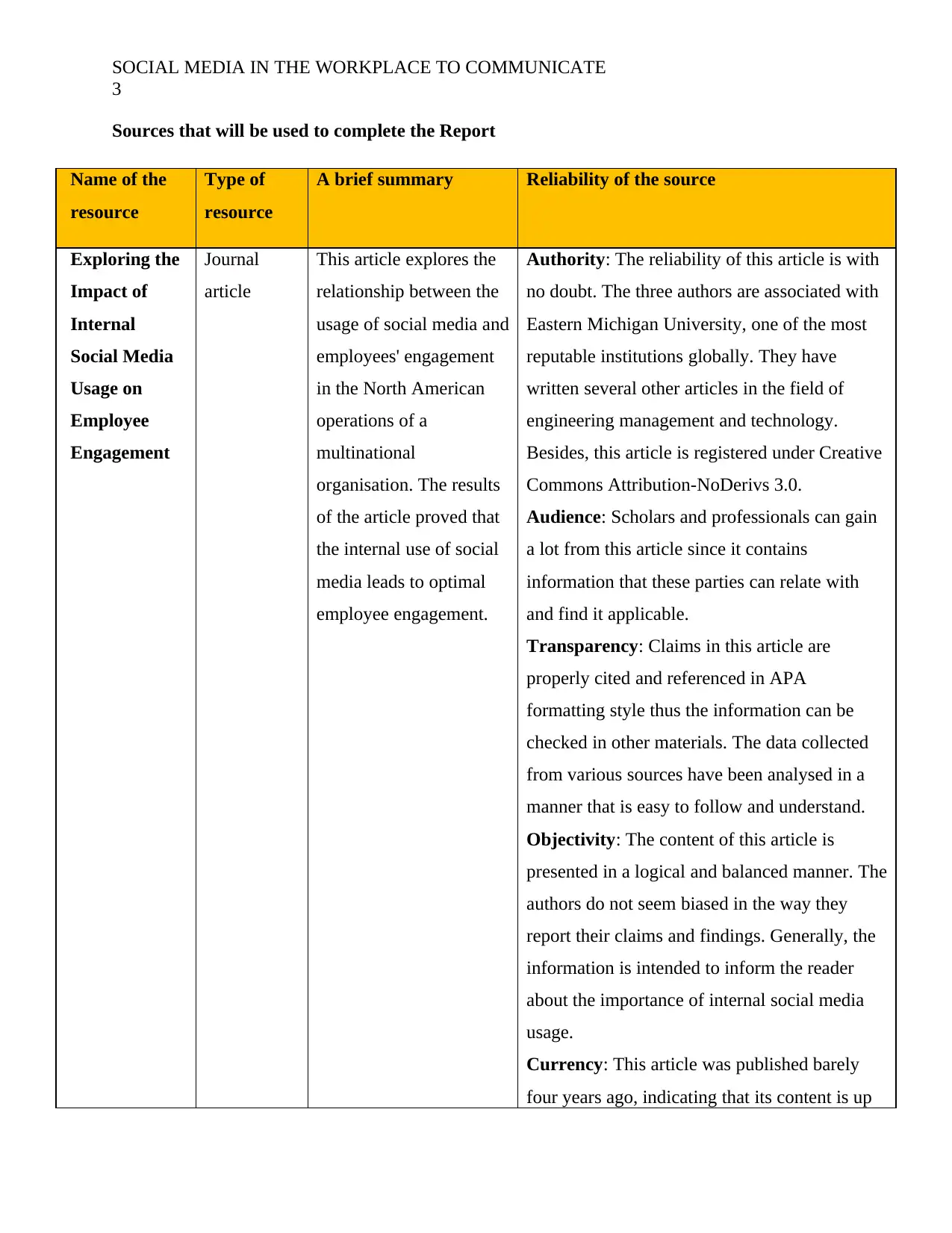
SOCIAL MEDIA IN THE WORKPLACE TO COMMUNICATE
3
Sources that will be used to complete the Report
Name of the
resource
Type of
resource
A brief summary Reliability of the source
Exploring the
Impact of
Internal
Social Media
Usage on
Employee
Engagement
Journal
article
This article explores the
relationship between the
usage of social media and
employees' engagement
in the North American
operations of a
multinational
organisation. The results
of the article proved that
the internal use of social
media leads to optimal
employee engagement.
Authority: The reliability of this article is with
no doubt. The three authors are associated with
Eastern Michigan University, one of the most
reputable institutions globally. They have
written several other articles in the field of
engineering management and technology.
Besides, this article is registered under Creative
Commons Attribution-NoDerivs 3.0.
Audience: Scholars and professionals can gain
a lot from this article since it contains
information that these parties can relate with
and find it applicable.
Transparency: Claims in this article are
properly cited and referenced in APA
formatting style thus the information can be
checked in other materials. The data collected
from various sources have been analysed in a
manner that is easy to follow and understand.
Objectivity: The content of this article is
presented in a logical and balanced manner. The
authors do not seem biased in the way they
report their claims and findings. Generally, the
information is intended to inform the reader
about the importance of internal social media
usage.
Currency: This article was published barely
four years ago, indicating that its content is up
3
Sources that will be used to complete the Report
Name of the
resource
Type of
resource
A brief summary Reliability of the source
Exploring the
Impact of
Internal
Social Media
Usage on
Employee
Engagement
Journal
article
This article explores the
relationship between the
usage of social media and
employees' engagement
in the North American
operations of a
multinational
organisation. The results
of the article proved that
the internal use of social
media leads to optimal
employee engagement.
Authority: The reliability of this article is with
no doubt. The three authors are associated with
Eastern Michigan University, one of the most
reputable institutions globally. They have
written several other articles in the field of
engineering management and technology.
Besides, this article is registered under Creative
Commons Attribution-NoDerivs 3.0.
Audience: Scholars and professionals can gain
a lot from this article since it contains
information that these parties can relate with
and find it applicable.
Transparency: Claims in this article are
properly cited and referenced in APA
formatting style thus the information can be
checked in other materials. The data collected
from various sources have been analysed in a
manner that is easy to follow and understand.
Objectivity: The content of this article is
presented in a logical and balanced manner. The
authors do not seem biased in the way they
report their claims and findings. Generally, the
information is intended to inform the reader
about the importance of internal social media
usage.
Currency: This article was published barely
four years ago, indicating that its content is up
⊘ This is a preview!⊘
Do you want full access?
Subscribe today to unlock all pages.

Trusted by 1+ million students worldwide
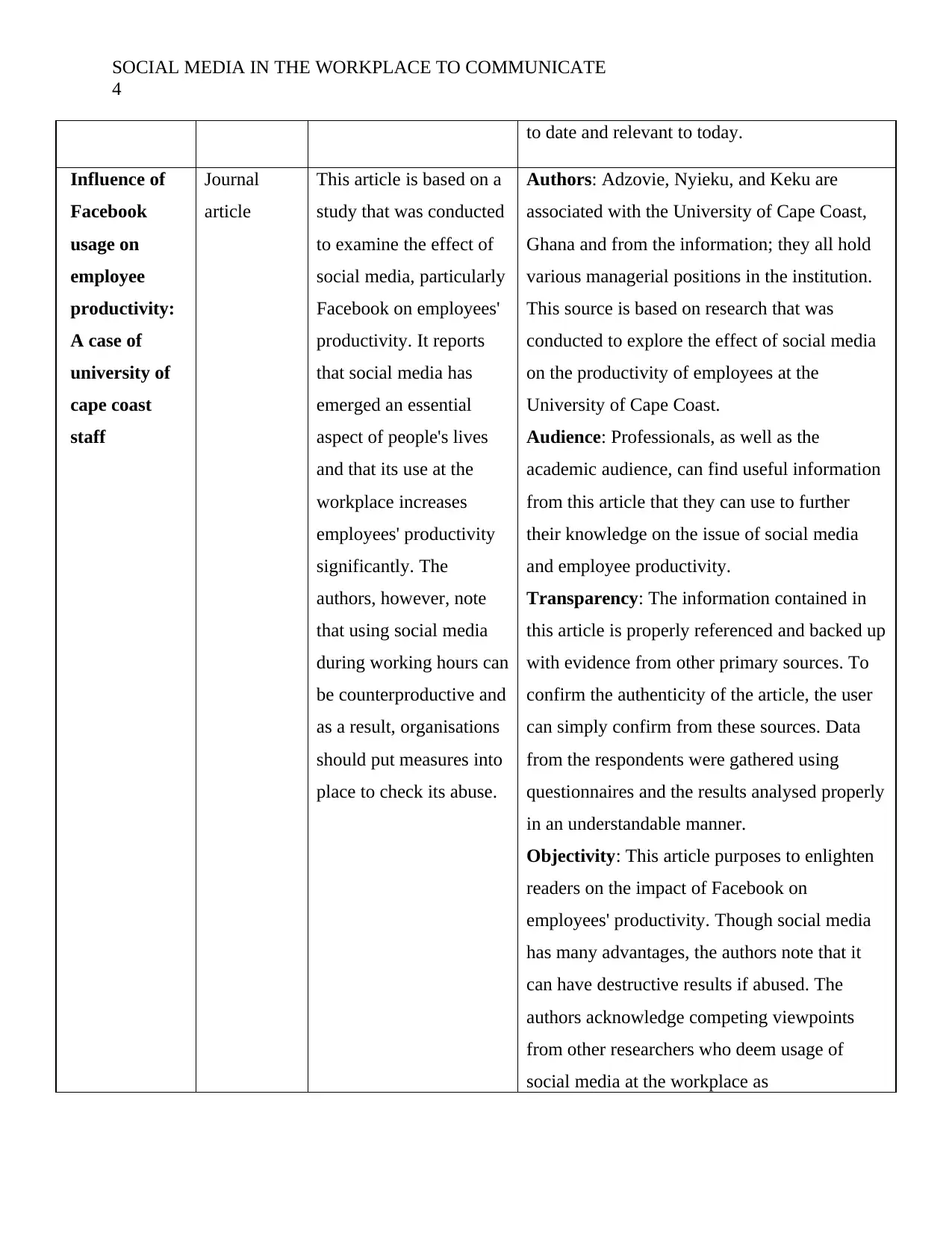
SOCIAL MEDIA IN THE WORKPLACE TO COMMUNICATE
4
to date and relevant to today.
Influence of
Facebook
usage on
employee
productivity:
A case of
university of
cape coast
staff
Journal
article
This article is based on a
study that was conducted
to examine the effect of
social media, particularly
Facebook on employees'
productivity. It reports
that social media has
emerged an essential
aspect of people's lives
and that its use at the
workplace increases
employees' productivity
significantly. The
authors, however, note
that using social media
during working hours can
be counterproductive and
as a result, organisations
should put measures into
place to check its abuse.
Authors: Adzovie, Nyieku, and Keku are
associated with the University of Cape Coast,
Ghana and from the information; they all hold
various managerial positions in the institution.
This source is based on research that was
conducted to explore the effect of social media
on the productivity of employees at the
University of Cape Coast.
Audience: Professionals, as well as the
academic audience, can find useful information
from this article that they can use to further
their knowledge on the issue of social media
and employee productivity.
Transparency: The information contained in
this article is properly referenced and backed up
with evidence from other primary sources. To
confirm the authenticity of the article, the user
can simply confirm from these sources. Data
from the respondents were gathered using
questionnaires and the results analysed properly
in an understandable manner.
Objectivity: This article purposes to enlighten
readers on the impact of Facebook on
employees' productivity. Though social media
has many advantages, the authors note that it
can have destructive results if abused. The
authors acknowledge competing viewpoints
from other researchers who deem usage of
social media at the workplace as
4
to date and relevant to today.
Influence of
usage on
employee
productivity:
A case of
university of
cape coast
staff
Journal
article
This article is based on a
study that was conducted
to examine the effect of
social media, particularly
Facebook on employees'
productivity. It reports
that social media has
emerged an essential
aspect of people's lives
and that its use at the
workplace increases
employees' productivity
significantly. The
authors, however, note
that using social media
during working hours can
be counterproductive and
as a result, organisations
should put measures into
place to check its abuse.
Authors: Adzovie, Nyieku, and Keku are
associated with the University of Cape Coast,
Ghana and from the information; they all hold
various managerial positions in the institution.
This source is based on research that was
conducted to explore the effect of social media
on the productivity of employees at the
University of Cape Coast.
Audience: Professionals, as well as the
academic audience, can find useful information
from this article that they can use to further
their knowledge on the issue of social media
and employee productivity.
Transparency: The information contained in
this article is properly referenced and backed up
with evidence from other primary sources. To
confirm the authenticity of the article, the user
can simply confirm from these sources. Data
from the respondents were gathered using
questionnaires and the results analysed properly
in an understandable manner.
Objectivity: This article purposes to enlighten
readers on the impact of Facebook on
employees' productivity. Though social media
has many advantages, the authors note that it
can have destructive results if abused. The
authors acknowledge competing viewpoints
from other researchers who deem usage of
social media at the workplace as
Paraphrase This Document
Need a fresh take? Get an instant paraphrase of this document with our AI Paraphraser
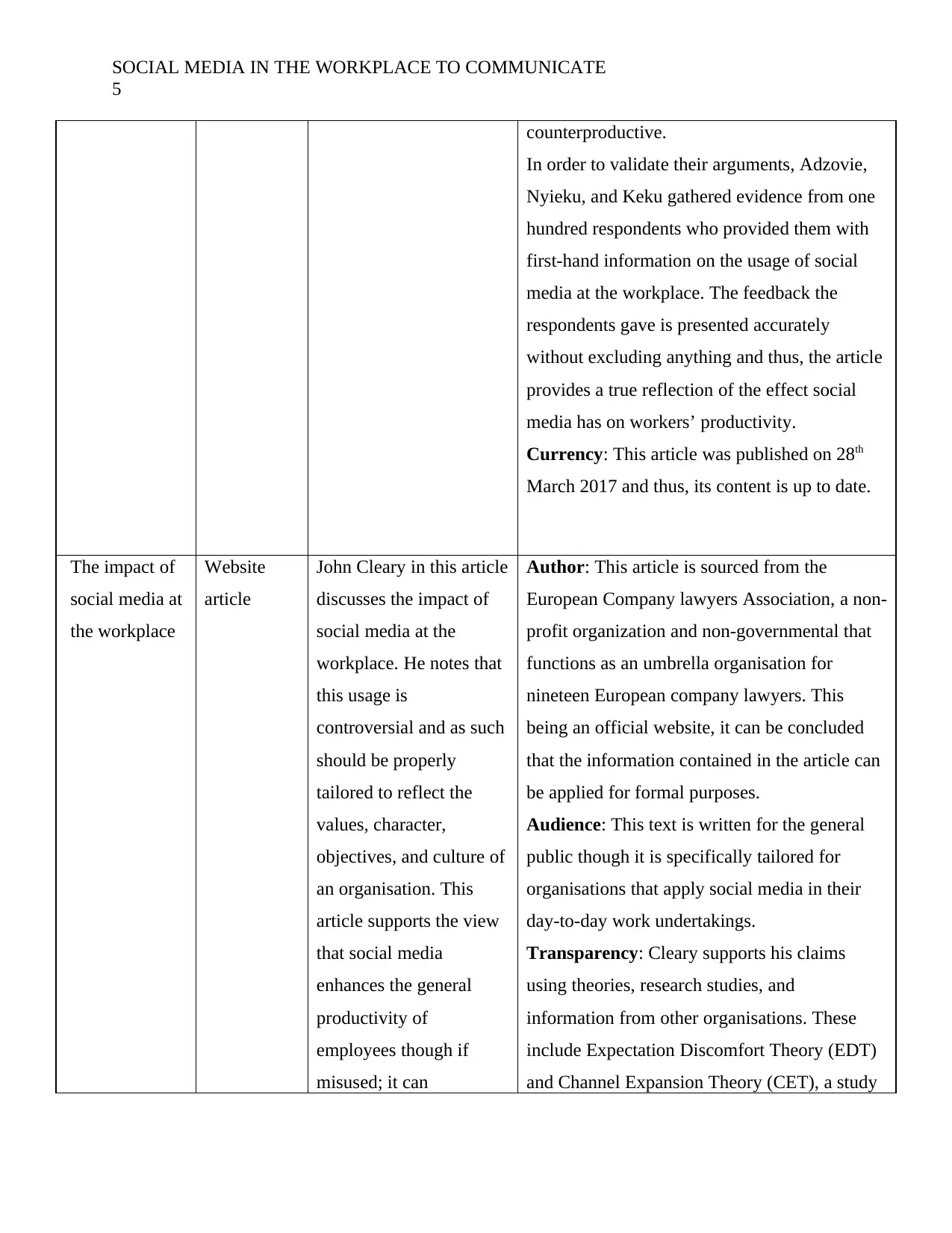
SOCIAL MEDIA IN THE WORKPLACE TO COMMUNICATE
5
counterproductive.
In order to validate their arguments, Adzovie,
Nyieku, and Keku gathered evidence from one
hundred respondents who provided them with
first-hand information on the usage of social
media at the workplace. The feedback the
respondents gave is presented accurately
without excluding anything and thus, the article
provides a true reflection of the effect social
media has on workers’ productivity.
Currency: This article was published on 28th
March 2017 and thus, its content is up to date.
The impact of
social media at
the workplace
Website
article
John Cleary in this article
discusses the impact of
social media at the
workplace. He notes that
this usage is
controversial and as such
should be properly
tailored to reflect the
values, character,
objectives, and culture of
an organisation. This
article supports the view
that social media
enhances the general
productivity of
employees though if
misused; it can
Author: This article is sourced from the
European Company lawyers Association, a non-
profit organization and non-governmental that
functions as an umbrella organisation for
nineteen European company lawyers. This
being an official website, it can be concluded
that the information contained in the article can
be applied for formal purposes.
Audience: This text is written for the general
public though it is specifically tailored for
organisations that apply social media in their
day-to-day work undertakings.
Transparency: Cleary supports his claims
using theories, research studies, and
information from other organisations. These
include Expectation Discomfort Theory (EDT)
and Channel Expansion Theory (CET), a study
5
counterproductive.
In order to validate their arguments, Adzovie,
Nyieku, and Keku gathered evidence from one
hundred respondents who provided them with
first-hand information on the usage of social
media at the workplace. The feedback the
respondents gave is presented accurately
without excluding anything and thus, the article
provides a true reflection of the effect social
media has on workers’ productivity.
Currency: This article was published on 28th
March 2017 and thus, its content is up to date.
The impact of
social media at
the workplace
Website
article
John Cleary in this article
discusses the impact of
social media at the
workplace. He notes that
this usage is
controversial and as such
should be properly
tailored to reflect the
values, character,
objectives, and culture of
an organisation. This
article supports the view
that social media
enhances the general
productivity of
employees though if
misused; it can
Author: This article is sourced from the
European Company lawyers Association, a non-
profit organization and non-governmental that
functions as an umbrella organisation for
nineteen European company lawyers. This
being an official website, it can be concluded
that the information contained in the article can
be applied for formal purposes.
Audience: This text is written for the general
public though it is specifically tailored for
organisations that apply social media in their
day-to-day work undertakings.
Transparency: Cleary supports his claims
using theories, research studies, and
information from other organisations. These
include Expectation Discomfort Theory (EDT)
and Channel Expansion Theory (CET), a study
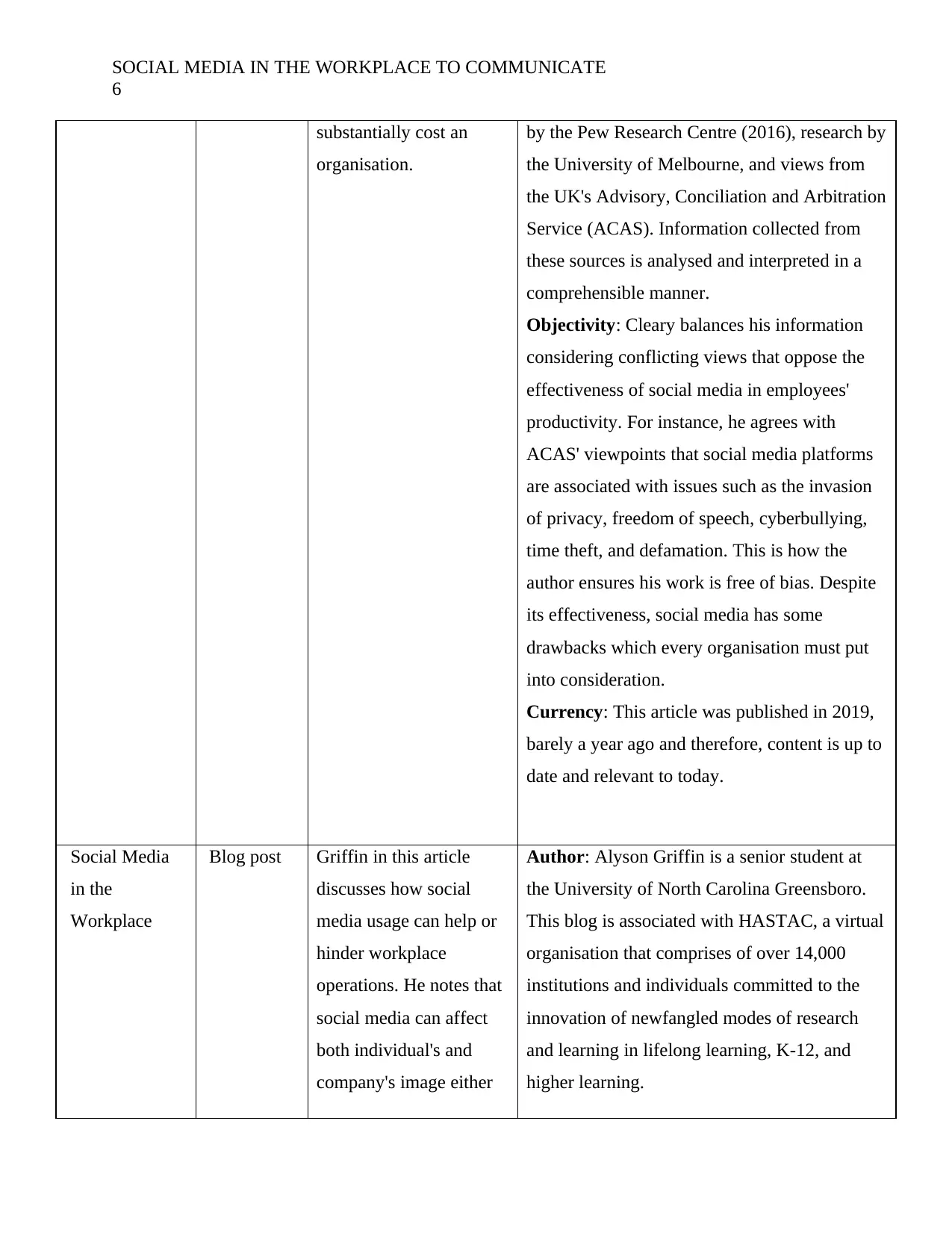
SOCIAL MEDIA IN THE WORKPLACE TO COMMUNICATE
6
substantially cost an
organisation.
by the Pew Research Centre (2016), research by
the University of Melbourne, and views from
the UK's Advisory, Conciliation and Arbitration
Service (ACAS). Information collected from
these sources is analysed and interpreted in a
comprehensible manner.
Objectivity: Cleary balances his information
considering conflicting views that oppose the
effectiveness of social media in employees'
productivity. For instance, he agrees with
ACAS' viewpoints that social media platforms
are associated with issues such as the invasion
of privacy, freedom of speech, cyberbullying,
time theft, and defamation. This is how the
author ensures his work is free of bias. Despite
its effectiveness, social media has some
drawbacks which every organisation must put
into consideration.
Currency: This article was published in 2019,
barely a year ago and therefore, content is up to
date and relevant to today.
Social Media
in the
Workplace
Blog post Griffin in this article
discusses how social
media usage can help or
hinder workplace
operations. He notes that
social media can affect
both individual's and
company's image either
Author: Alyson Griffin is a senior student at
the University of North Carolina Greensboro.
This blog is associated with HASTAC, a virtual
organisation that comprises of over 14,000
institutions and individuals committed to the
innovation of newfangled modes of research
and learning in lifelong learning, K-12, and
higher learning.
6
substantially cost an
organisation.
by the Pew Research Centre (2016), research by
the University of Melbourne, and views from
the UK's Advisory, Conciliation and Arbitration
Service (ACAS). Information collected from
these sources is analysed and interpreted in a
comprehensible manner.
Objectivity: Cleary balances his information
considering conflicting views that oppose the
effectiveness of social media in employees'
productivity. For instance, he agrees with
ACAS' viewpoints that social media platforms
are associated with issues such as the invasion
of privacy, freedom of speech, cyberbullying,
time theft, and defamation. This is how the
author ensures his work is free of bias. Despite
its effectiveness, social media has some
drawbacks which every organisation must put
into consideration.
Currency: This article was published in 2019,
barely a year ago and therefore, content is up to
date and relevant to today.
Social Media
in the
Workplace
Blog post Griffin in this article
discusses how social
media usage can help or
hinder workplace
operations. He notes that
social media can affect
both individual's and
company's image either
Author: Alyson Griffin is a senior student at
the University of North Carolina Greensboro.
This blog is associated with HASTAC, a virtual
organisation that comprises of over 14,000
institutions and individuals committed to the
innovation of newfangled modes of research
and learning in lifelong learning, K-12, and
higher learning.
⊘ This is a preview!⊘
Do you want full access?
Subscribe today to unlock all pages.

Trusted by 1+ million students worldwide
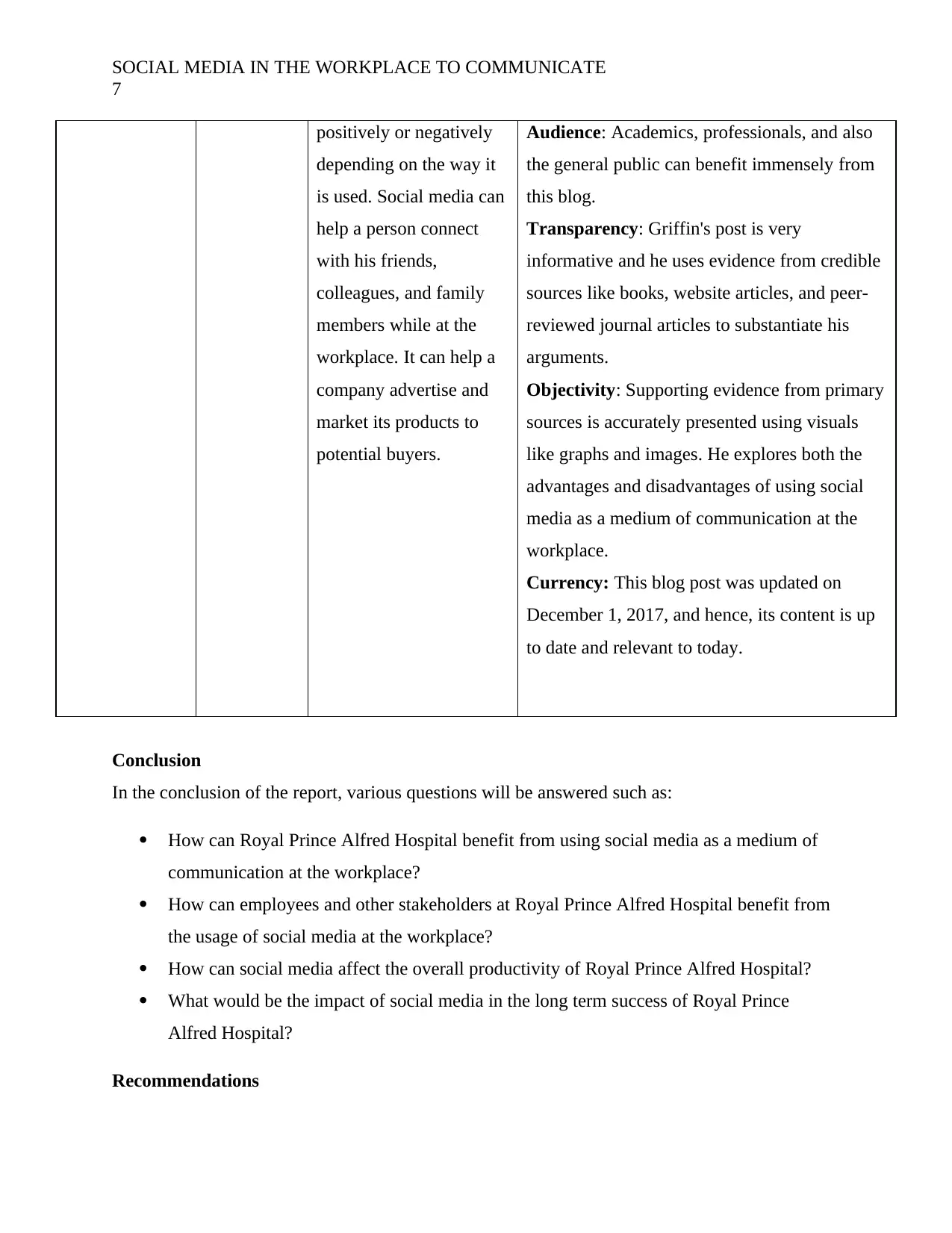
SOCIAL MEDIA IN THE WORKPLACE TO COMMUNICATE
7
positively or negatively
depending on the way it
is used. Social media can
help a person connect
with his friends,
colleagues, and family
members while at the
workplace. It can help a
company advertise and
market its products to
potential buyers.
Audience: Academics, professionals, and also
the general public can benefit immensely from
this blog.
Transparency: Griffin's post is very
informative and he uses evidence from credible
sources like books, website articles, and peer-
reviewed journal articles to substantiate his
arguments.
Objectivity: Supporting evidence from primary
sources is accurately presented using visuals
like graphs and images. He explores both the
advantages and disadvantages of using social
media as a medium of communication at the
workplace.
Currency: This blog post was updated on
December 1, 2017, and hence, its content is up
to date and relevant to today.
Conclusion
In the conclusion of the report, various questions will be answered such as:
How can Royal Prince Alfred Hospital benefit from using social media as a medium of
communication at the workplace?
How can employees and other stakeholders at Royal Prince Alfred Hospital benefit from
the usage of social media at the workplace?
How can social media affect the overall productivity of Royal Prince Alfred Hospital?
What would be the impact of social media in the long term success of Royal Prince
Alfred Hospital?
Recommendations
7
positively or negatively
depending on the way it
is used. Social media can
help a person connect
with his friends,
colleagues, and family
members while at the
workplace. It can help a
company advertise and
market its products to
potential buyers.
Audience: Academics, professionals, and also
the general public can benefit immensely from
this blog.
Transparency: Griffin's post is very
informative and he uses evidence from credible
sources like books, website articles, and peer-
reviewed journal articles to substantiate his
arguments.
Objectivity: Supporting evidence from primary
sources is accurately presented using visuals
like graphs and images. He explores both the
advantages and disadvantages of using social
media as a medium of communication at the
workplace.
Currency: This blog post was updated on
December 1, 2017, and hence, its content is up
to date and relevant to today.
Conclusion
In the conclusion of the report, various questions will be answered such as:
How can Royal Prince Alfred Hospital benefit from using social media as a medium of
communication at the workplace?
How can employees and other stakeholders at Royal Prince Alfred Hospital benefit from
the usage of social media at the workplace?
How can social media affect the overall productivity of Royal Prince Alfred Hospital?
What would be the impact of social media in the long term success of Royal Prince
Alfred Hospital?
Recommendations
Paraphrase This Document
Need a fresh take? Get an instant paraphrase of this document with our AI Paraphraser
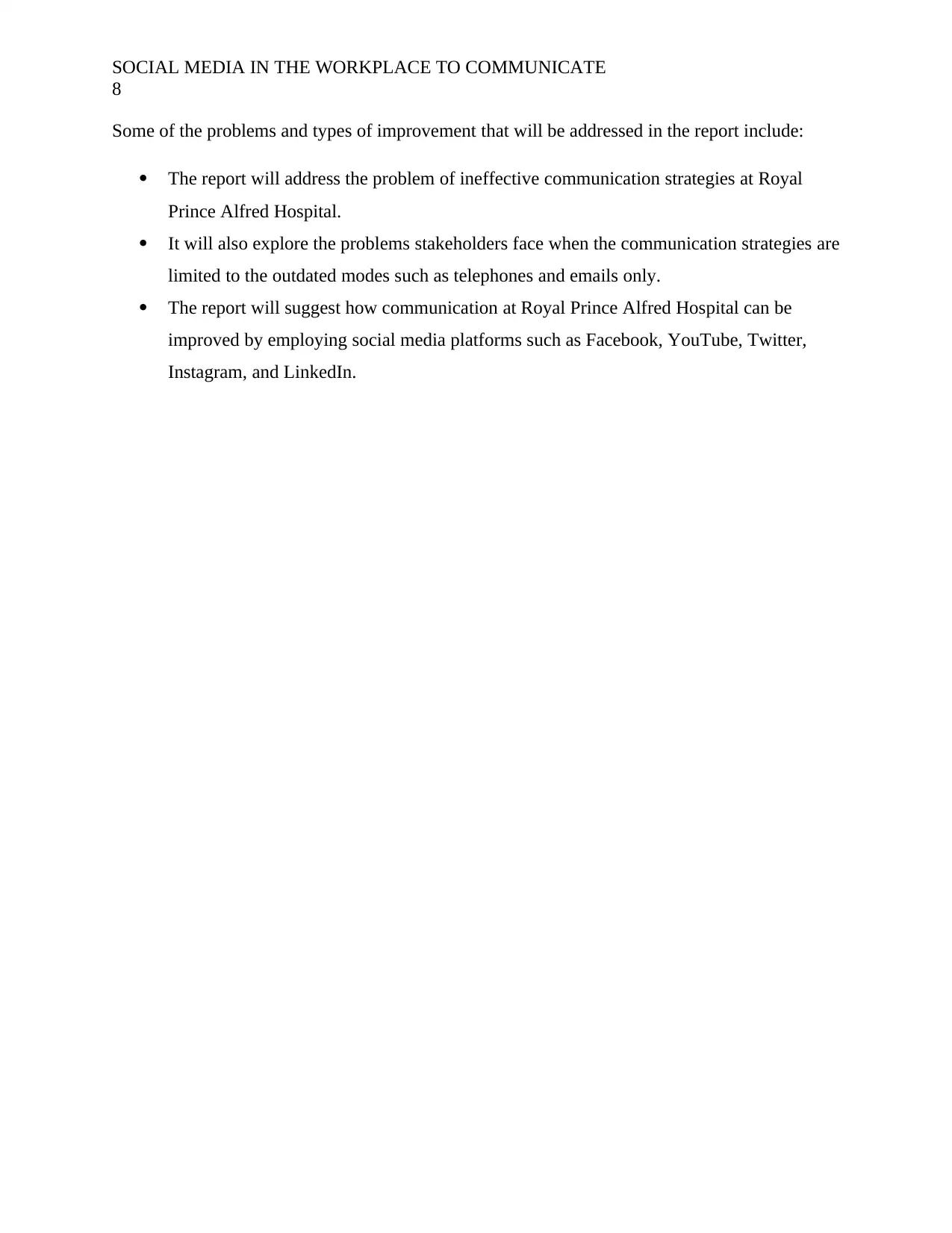
SOCIAL MEDIA IN THE WORKPLACE TO COMMUNICATE
8
Some of the problems and types of improvement that will be addressed in the report include:
The report will address the problem of ineffective communication strategies at Royal
Prince Alfred Hospital.
It will also explore the problems stakeholders face when the communication strategies are
limited to the outdated modes such as telephones and emails only.
The report will suggest how communication at Royal Prince Alfred Hospital can be
improved by employing social media platforms such as Facebook, YouTube, Twitter,
Instagram, and LinkedIn.
8
Some of the problems and types of improvement that will be addressed in the report include:
The report will address the problem of ineffective communication strategies at Royal
Prince Alfred Hospital.
It will also explore the problems stakeholders face when the communication strategies are
limited to the outdated modes such as telephones and emails only.
The report will suggest how communication at Royal Prince Alfred Hospital can be
improved by employing social media platforms such as Facebook, YouTube, Twitter,
Instagram, and LinkedIn.
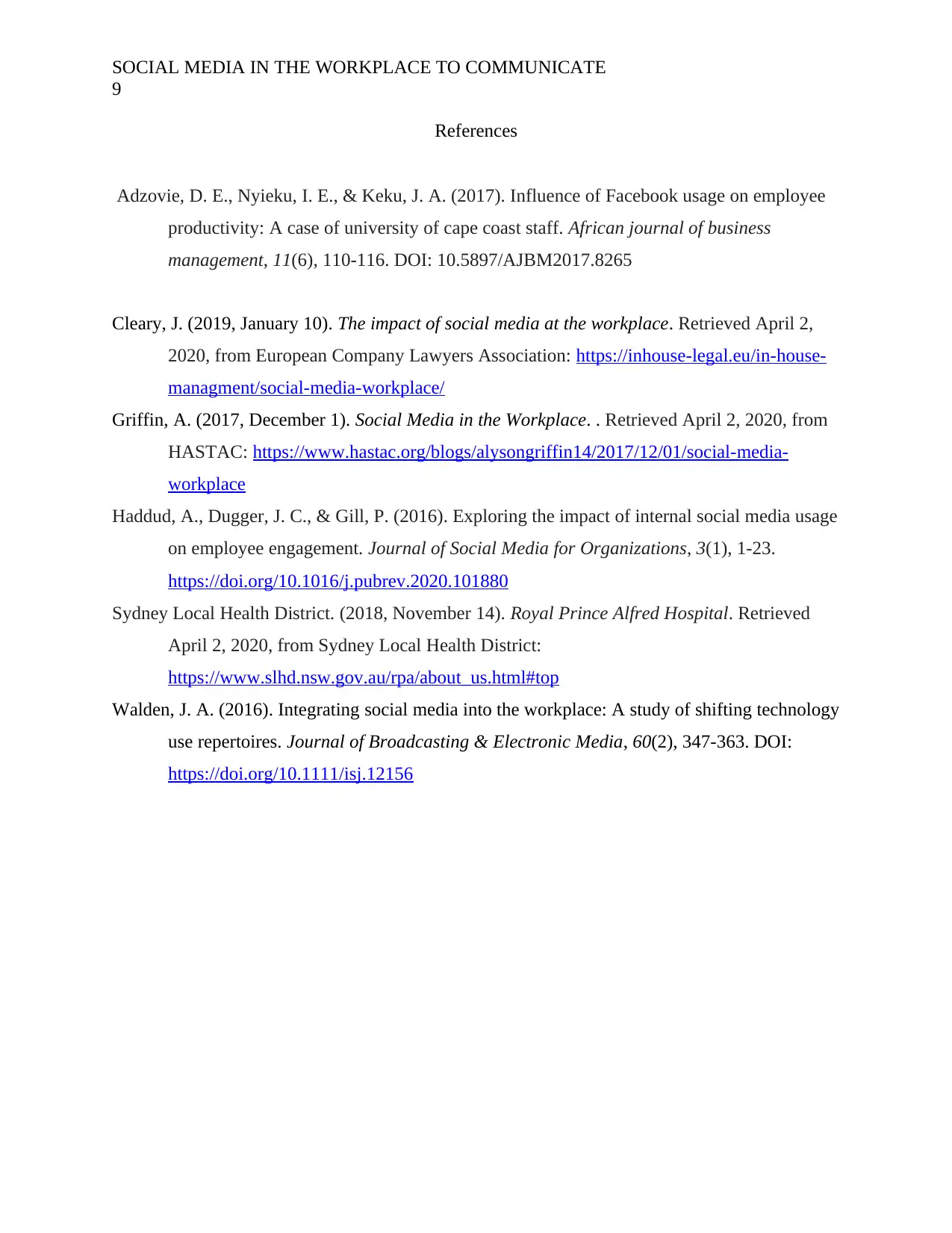
SOCIAL MEDIA IN THE WORKPLACE TO COMMUNICATE
9
References
Adzovie, D. E., Nyieku, I. E., & Keku, J. A. (2017). Influence of Facebook usage on employee
productivity: A case of university of cape coast staff. African journal of business
management, 11(6), 110-116. DOI: 10.5897/AJBM2017.8265
Cleary, J. (2019, January 10). The impact of social media at the workplace. Retrieved April 2,
2020, from European Company Lawyers Association: https://inhouse-legal.eu/in-house-
managment/social-media-workplace/
Griffin, A. (2017, December 1). Social Media in the Workplace. . Retrieved April 2, 2020, from
HASTAC: https://www.hastac.org/blogs/alysongriffin14/2017/12/01/social-media-
workplace
Haddud, A., Dugger, J. C., & Gill, P. (2016). Exploring the impact of internal social media usage
on employee engagement. Journal of Social Media for Organizations, 3(1), 1-23.
https://doi.org/10.1016/j.pubrev.2020.101880
Sydney Local Health District. (2018, November 14). Royal Prince Alfred Hospital. Retrieved
April 2, 2020, from Sydney Local Health District:
https://www.slhd.nsw.gov.au/rpa/about_us.html#top
Walden, J. A. (2016). Integrating social media into the workplace: A study of shifting technology
use repertoires. Journal of Broadcasting & Electronic Media, 60(2), 347-363. DOI:
https://doi.org/10.1111/isj.12156
9
References
Adzovie, D. E., Nyieku, I. E., & Keku, J. A. (2017). Influence of Facebook usage on employee
productivity: A case of university of cape coast staff. African journal of business
management, 11(6), 110-116. DOI: 10.5897/AJBM2017.8265
Cleary, J. (2019, January 10). The impact of social media at the workplace. Retrieved April 2,
2020, from European Company Lawyers Association: https://inhouse-legal.eu/in-house-
managment/social-media-workplace/
Griffin, A. (2017, December 1). Social Media in the Workplace. . Retrieved April 2, 2020, from
HASTAC: https://www.hastac.org/blogs/alysongriffin14/2017/12/01/social-media-
workplace
Haddud, A., Dugger, J. C., & Gill, P. (2016). Exploring the impact of internal social media usage
on employee engagement. Journal of Social Media for Organizations, 3(1), 1-23.
https://doi.org/10.1016/j.pubrev.2020.101880
Sydney Local Health District. (2018, November 14). Royal Prince Alfred Hospital. Retrieved
April 2, 2020, from Sydney Local Health District:
https://www.slhd.nsw.gov.au/rpa/about_us.html#top
Walden, J. A. (2016). Integrating social media into the workplace: A study of shifting technology
use repertoires. Journal of Broadcasting & Electronic Media, 60(2), 347-363. DOI:
https://doi.org/10.1111/isj.12156
⊘ This is a preview!⊘
Do you want full access?
Subscribe today to unlock all pages.

Trusted by 1+ million students worldwide
1 out of 9
Related Documents
Your All-in-One AI-Powered Toolkit for Academic Success.
+13062052269
info@desklib.com
Available 24*7 on WhatsApp / Email
![[object Object]](/_next/static/media/star-bottom.7253800d.svg)
Unlock your academic potential
Copyright © 2020–2025 A2Z Services. All Rights Reserved. Developed and managed by ZUCOL.




